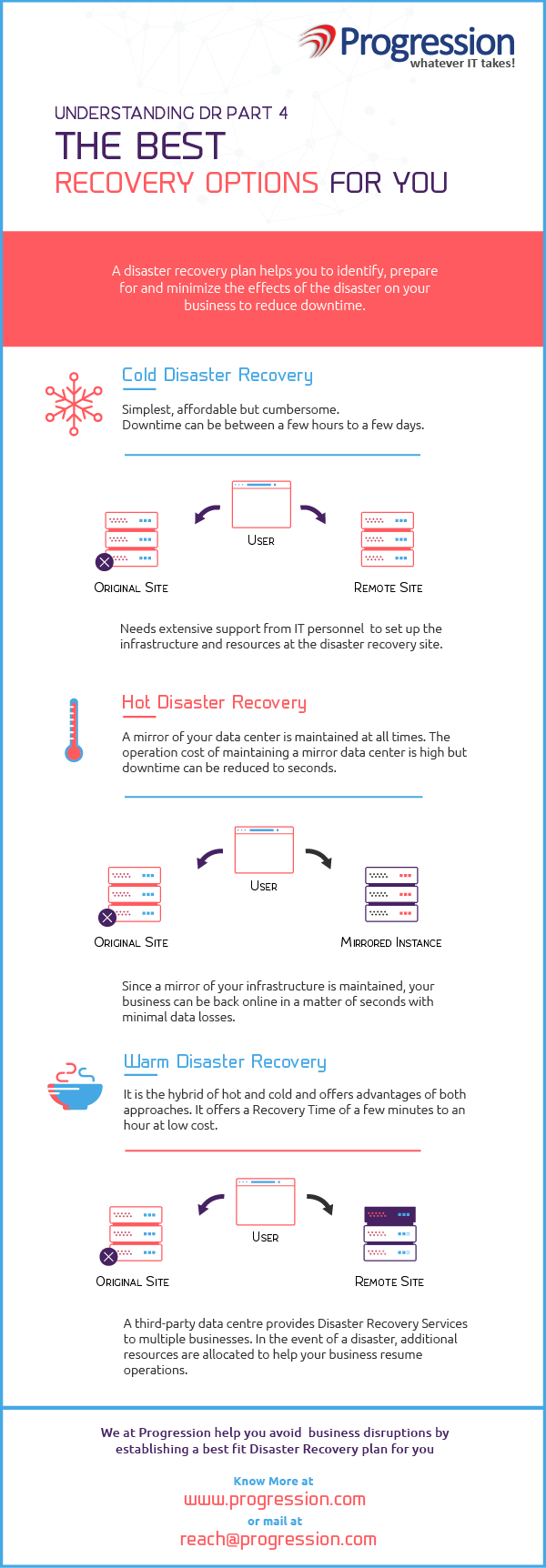When disaster strikes, a good Disaster Recovery Plan (DRP) should ensure that critical business operations resume as quickly as possible. High downtimes can adversely affect your business, causing serious revenues losses, customer dissatisfaction and damaging your company’s reputation. To bring operations back on track your business needs Disaster Recovery as a Service (DRaaS). The performance and the kind of DR options that one opts for define how quickly your business can recover from a disaster. This performance comes at a cost. Evaluating cost vs performance is an effective method to deduce which DR Plan is best for your business. Know more about our Disaster Recovery offerings here Primarily, there are three types of Disaster Recovery Options: Cold, Hot and Warm.
 Cold Disaster Recovery
Cold Disaster Recovery
Cold Disaster Recovery includes a recovery site (say a company owned or third party Data Centre). Backups of the data happen at the remote DC; however, there is no dedicated or allocated hardware (physical or virtual) for a given company. When disaster strikes at the primary site, one would either ask for the data to be shipped back from the Cold site or production setup is created at the DR site. However, owing to lack of dedicated or available servers at the DR site could mean that recovery in Cold DR can take days or weeks. Cold DR comes at the lowest cost (among the three options) as it only needs basic infrastructure. But it’s high failover times, makes it undesirable for most businesses and applications. As there is no dedicated hardware, DR drills on Cold DR aren’t possible, making it impossible to test and assess your DRP and having the assurance that your DR would successfully come up during the time of a Disaster. Hot Disaster Recovery Hot Disaster Recovery uses an exact replica of your IT Infrastructure at a secondary DR site. The recovery site synchronizes everything – the operating system, application state, any dependencies along with data from the primary site in real time. This means that your business operations can be resumed from the recovery site almost instantaneously in the event of a disaster. The biggest drawback of Hot DR is its cost. The cost of setting up and managing two fully operational systems, with real-time data replication and constant supervision, irrespective of if and when there is a disruption, makes Hot DR out of reach for most companies. Warm Disaster Recovery Warm Disaster Recovery is a hybrid of Cold and Hot Disaster Recovery. It typically includes working with a third-party Disaster Recovery Service Provider that offers a high-end Data Centre, DR tools and expertise to cater to multiple businesses. The Data Centre performs periodic updates of the OS and applications state along with near real-time data sync for all the supported IT Infrastructure and Applications. However, the DR options may be available on scaled down infrastructure and most times virtualized to bring down costs significantly while providing the benefits of a Hot DR. In the event of a disaster, resources allocated to the affected business are typically scaled up to help it resume operations. This ensures low recovery times, without the high costs associated with Hot DR. Typically, the average Recovery Time of Warm DR is a few hours (RTO) and data loss (RPO) not exceeding a few minutes. Warm DR also allows you to perform DR Drills with your service provider, helping you gauge and improve the effectiveness of your DRP. Progression can help We at Progression help set up the best DR option for your organization based on your cost and recovery time requirements. We provide DRaaS via our own and leading third-party Data Centres across Gurgaon, Chennai and Mumbai currently as well as AWS and Azure. To find out more about how we can help protect your business, please leave us your contact details here or call us at +91-124-6670100. In the final blog of this series, we will look at how the public cloud can be used for cost-effective disaster recovery.


